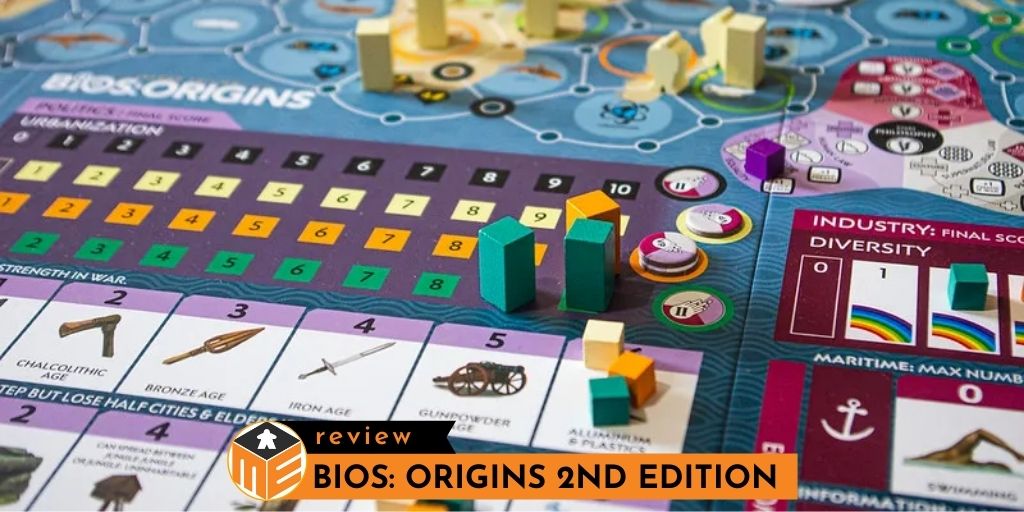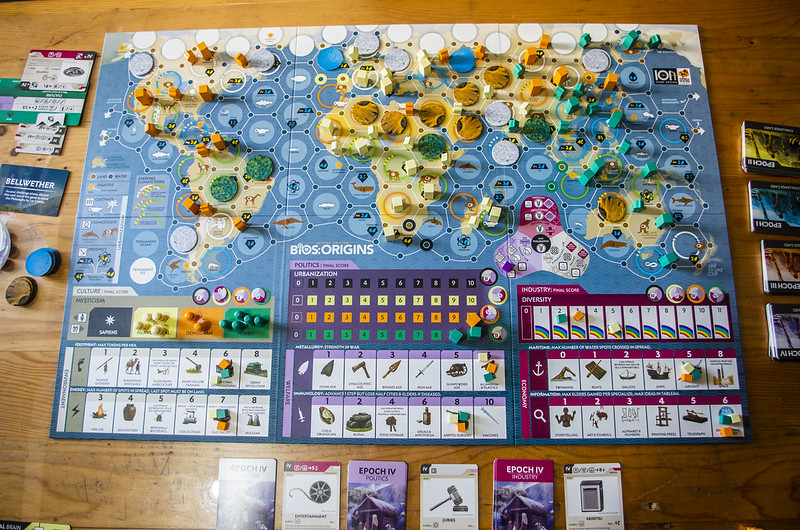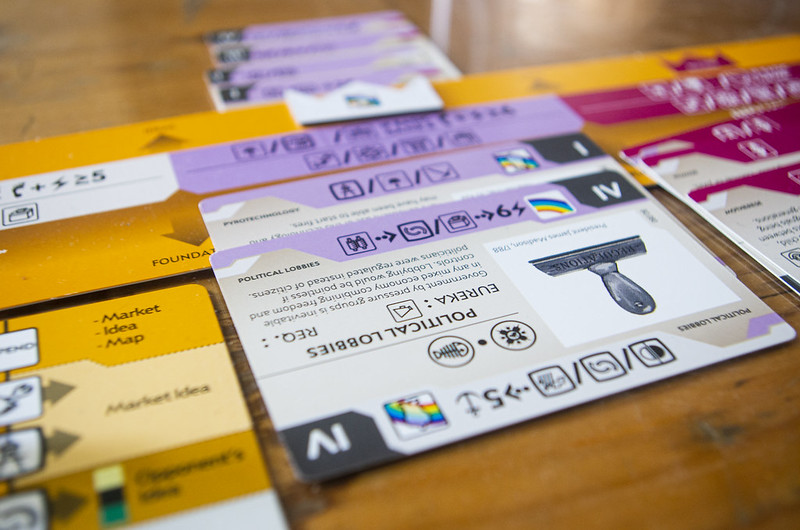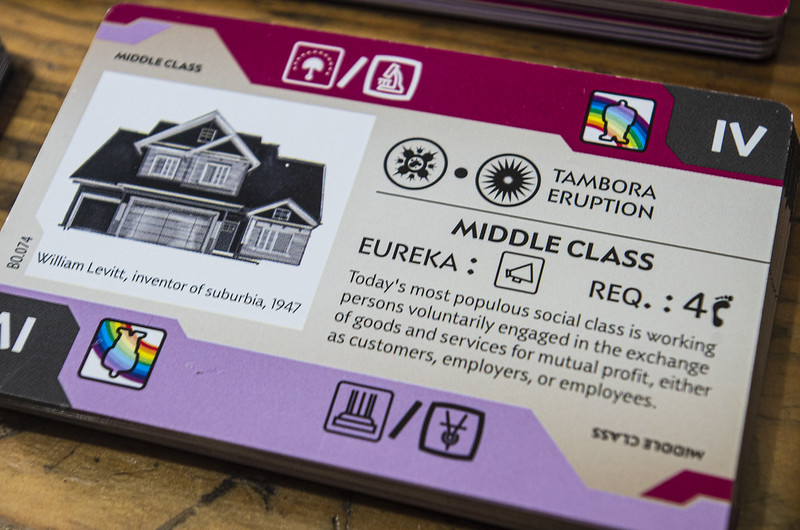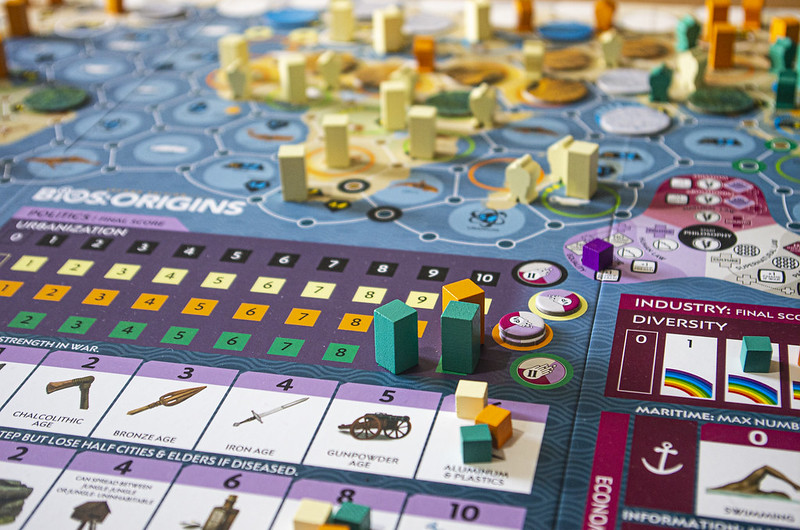As the next sequel of Bios: Megafauna, this game takes place 200 thousand years ago. It was an era when some human subspecies emerged and evolved. The long epoch stretched up to the point with only one of them survived on Earth. This remaining species is us, the modern human, assumed to be blessed with the gift of mind. This is Bios: Origins 2nd Edition.
Phil Eklund is an eccentric game designer whose career can be traced back to the late 1980s. He has been successful with the development of board games full of history and science. The mechanic in his masterpieces is eminent to illustrate the thematic subject. My standard for this aspect has quite rocketed since I got exposed with more titles from Eklund.
For those who don’t know, Bios: Origins 2nd Edition is a reimplementation of Origins: How We Became Human. This game was released in 2007. Unfortunately, I haven’t got my hand on this forerunner.
It takes two to tango, Eklund was duetting with Jon Manker for the reimplementation. My whole thesis here is only focused on the current reimplementation version. This will be exclusively for Bios: Origins 2nd Edition, without any effort to compare both titles.
BIOS SERIES AND THE JOURNEY OF EARTH UP TO THIS POINT
My first engagement with Bios the trilogy was around a year ago. The premise was clear: making a grand campaign out of the trio. The story began with the unicellular being and its struggles to survive during the dawn of the planet Earth (Genesis). Along the way, they adapted, hunted, and created the food chain (Megafauna). In the end, the evolution led them to become human (Origins).
At this point, they started to process their surroundings. The first humans became self-conscious, and learnt to exploit their ideas and minds. It was the starting point of their competition to become the best on the small green planet they called home.
Well, it may be a bit far-fetched, but this story can continue to High Frontier 4 and become a tetralogy instead. I’m sure it would be an interesting intellectual sparring to write about it in the upcoming future.
BIOS: ORIGINS 2ND EDITION — THE TRILOGY’S EPILOGUE & PROLOGUE OF THE HUMANKIND
In this game, each of us takes one role out of the four human subspecies. All species are equipped with the same initial skill, but they start from different locations.
Our role is not only to control an alpha-individual of that species. To be more concrete, we pull the strings for all the human beings of your class.
All of them controls the necessities, initiating the intelligence growth, and most importantly, the skill to adapt new ideas and indoctrinate principals to survive the harsh life on Earth. This is Phil Eklund’s awesome illustration of living in our planet.
THE GAME STRUCTURES
Bios: Origins 2nd Edition has a simple and nice structure. There are four epochs in this game, and they represent the rounds. In each round, all players will undergo three primary phases.
An epoch starts with the ‘Challenge the God’ phase. In their turn, a player may draw an Event card from the deck. This deck becomes a timer for each specific epoch in Bios: Origins 2nd Edition. The cards impose challenges and often change the situation on the map. They simulate some real substantial events in the past, for example the eruption of Krakatoa Volcano and the cardinal time human utilized illustrations and writings as a persuasive method.
Activity phase is the main juncture of Bios: Origins 2nd Edition. Thanks to round about 20 actions, many possibilities can happen here. At the beginning of the game, each species has six possibilities only, and they are slightly different based on the ruling class, politic, culture, industry, and the specialization respectively.
Along the game, it becomes more asymmetrical in this phase. It really depends on the engine we want (or get forced) to build. Please don’t let yourself get intimidated by the rising in-game possibilities. Thematically, we get to understand the game easier when we get to know the topic brought into the details.
The last phase would be Footprint and Restore Market. Basically, this is a clean-up opportunity while checking whether there is any overpopulation in some regions. It may lead to famine and death of the active player’s species.
Repeat all of these phases until the fourth epoch, and the scoring will follow afterwards. The species with the best adaptation skill on three main segments (politic, culture, and industry) becomes the winner.
A synopsis of the campaign we created
Actually, I intentionally wrote this part to rehearse my Bios experience. You can just skip this part if you are not interested.
Three players narrated the story for this series. Denisovans (a descendant of Homo erectus) began their journey in China. Meanwhile, the hobbits (Homo floresiensis) started their archaic inhabitation in Indonesia. Along with them, we also had the Neanderthals (Homo neanderthalensis) in Spain.
In the first epoch, the hobbits successfully converted Free Will into Mysticism. They left the primitive Denisovans and Neanderthals, looking forward and not above. During the same round, the hobbits developed the idea of Preaching. Thanks to this method, they spread their ideologies and converted a settlement from Denisovans.
Despite not being so advance in ideas and thoughts, both Denisovans and Neanderthals had started agriculture and mining. It was a breakthrough for that age, since they found values in something else beside consumption and procreation.
As the second epoch went by, the Neanderthals understood the world better. They knew the importance of Free Will and freed their Emotion. Hence, they became superior when finding new ideas. The Denisovans went to be fundamentalist and indoctrinated the Foundation to their offspring.
However, the Preaching developed by the hobbits from the previous epoch made it hard for both Denisovans and Neanderthals to stop the spread of the hobbits’ teaching. We then unanimously agreed to keep the peace and continued our ways separately.
In the end, we divided our dominions. The Denisovans ruled the America region. Consecutively, Asia and some parts of Europe were under the hobbit’s rule. The rest of Europe and Africa belonged to the Neanderthals. It was a peaceful time, indeed.
The second half-time
Most of the disasters came out in the third epoch. Pandemic, natural disasters, we have gone them through. Consequently, we lost many things during this round. There were Silent Revolutions on the brink or even already breaking. Hence, the game forced us to adapt and leave the old ways to survive. Additionally, we still needed to develop the intellectual sides of our species.
Actually, something interesting happened in the last epoch. We kept the peace until the end of the game. Initially, we planned to have a big aggression between species in this era. Our decision to keep being pacifists was because we were satisfied already with the wealth, ideology, and our specialities. The species evolved and grew in harmony.
THOUGHTS ON BIOS: ORIGINS 2ND EDITION
For me, Bios: Origins 2nd Edition is like fragmented narratives that I alone or with up to other three players conflate together. We could be taking a trip down memory lane and reminiscing this epic chronicle. Whether it stays a fiction or becomes a lesson to embrace oneself is each player’s personal choice.
Each epoch provides unique skills to each player through some specific cards utilized and adapted as ideas and principles. These cards help the species to grow and evolve. In the late game, all of them can choose whether to be a tyrant with their nuclear power or a pacifist whose mission is to focus on arts and cultures.
AN ENGINE-BUILDING MECHANIC WITHIN the game
Let’s come back a bit to the parts where drawing an Event card is optional. After going through all events, these cards will be put in an auction and become Foundations. I identified and mentioned this several times with the term ‘principle’ before. This auction is fused as a unique engine-building concept into Bios: Origins 2nd Edition.
OVERALL IMPRESSION
My very first session with Bios: Origins 2nd Edition was an exciting experience. In fact, I like the epoch transition and seeing the new ideas depicted in cards. Was this the same feeling I shared with the first humans during their enlightenment era? Furthermore, the ability to adapt to changes becomes the essential key to win.
In a good way, this game is a bit chaotic with the narrative. The designers have combined both strategic and tactical in a box.
All things we do in the game, both mechanic (gameplay) and thematic (terms and all the flavour text on the cards and actions) are a beautiful combination, proudly presented by Phil Eklund for the players. Finally, Bios: Origins 2nd Edition really offers the chance to build an epic campaign of human and its evolution. Be it with table talk or just you solo-ing the game, it can be a nice experience.
Do you love board games as much as we do? Support us!
Thank you for reading our articles! If you enjoyed our work and want more captivating board game contents, make sure to:
👉 Follow us on our social media — you can find us on ![]()
![]()
![]() Click one of the icons to land on our social media, or find us @meepleeksyen there, it’s just a click away! Stay updated with our latest board game reviews and previews by following us on those platforms 📱👍
Click one of the icons to land on our social media, or find us @meepleeksyen there, it’s just a click away! Stay updated with our latest board game reviews and previews by following us on those platforms 📱👍
💬 Do you have contrasting opinions? Leave a comment — share your thoughts with us, we’d love to hear (or read) yours! Have you played this game before? Did you have something similar as well? Or perhaps, something more personal, like what are your favourite board games? Let’s discuss in the comments below!
🙏 Support Us! Your generous support can help us produce even better content in the future. If you love what we do, consider making a donation to our blog. Every contribution counts and means a lot to us! You can either donate locally with Indonesian Rupiah (IDR) via Trakteer ![]() or for international readers with another currency through Buy Me a Coffee
or for international readers with another currency through Buy Me a Coffee ![]() It helps us to survive, too! 💰 Click one of the button below 👇
It helps us to survive, too! 💰 Click one of the button below 👇
Original text: Aditya Martodiharjo
Editing & English translation by: Stephan Celebesario Sonny

